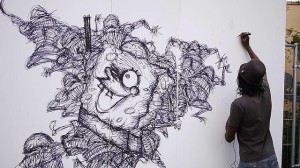Of all the galleries in Paris that I’ve been to, Wallworks in the tenth arrondissement was the hardest to find, but perhaps the nicest surprise. Parking my bike outside, the address I had been given looked particularly private, with several courtyards stretching back, doors leading off left and right, and had nothing of the public (read: anyone-welcome) gallery ambience about it. Pleased with finally finding the right door, I was buzzed in without any questions being asked…and found myself on a dark stairwell. Hmm.
Given that the gallery is known for its urban art exhibitions, I decided to follow the graffiti…down, and ended up in the cellar. Bingo. An open door on the left showed me that my art-nose was spot on.

Until 2009, France was lagging behind in urban art circles. Now there is a street art sale every month. By the late 1980s, Crash (aka John Matos) had already exhibited across the US (and elsewhere). We Europeans had some catching-up to do…
It is true, though, that urban art carries within its fibres a history of rebellion, a middle-finger to those who like their walls white. Crash’s exhibition “Letting Ink Dry” doesn’t ignore his Bronx roots, but makes his art accessible to a wider public. Fragments of a larger idea, a bigger canvas, his style implies clever graffiti snapshots, a segment of a wider scene. The pieces displayed are a combination of his earlier work as well as thirty new watercolours (created expressly for this exhibition, gallery owner Claude Kunetz explained) where Crash shows that his art is more than spray-paint, deliberately using a conventional medium associated more with pastoral landscapes than graffiti using comic-book inspired visuals including slogans such as “BLAM!” (now Whaam, I know, but Blam was new to me).

While I enjoyed the watercolours, I found his earlier work more exciting. I prefer the rawer edges, the dimensions built up using metals, plastic, spay, acrylic and so on…where the piece is accessible, not displayed behind a glass window. Perhaps my hesitation towards to the watercolours was their lack of…context. I associate urban art (especially graffiti) with the scene it accompanies; the cultural photograph it provides. But maybe urban art is moving past this and is now being redefined as a genre in its own right, able to hold a frame without having to provide a background.
John CRASH Matos now sells his work for between 5000 and 20,000 euros per piece. A graffiti artist (bomber) since he was 13, his pen name comes from a malfunction in a computer programming class he took. He is perhaps most famous for the painted guitars (“Crashocasters”) he produced for Eric Clapton.

Letting Ink Dry is a great exhibition where those unfamiliar to Crash can really taste what he’s about. Wallworks is a gallery to watch out for and, as for Crash, well I have a feeling that we won’t be able to help but see him…everywhere.















